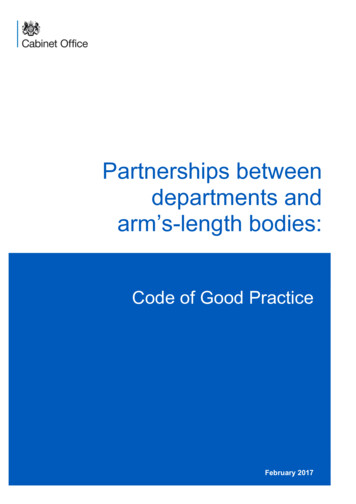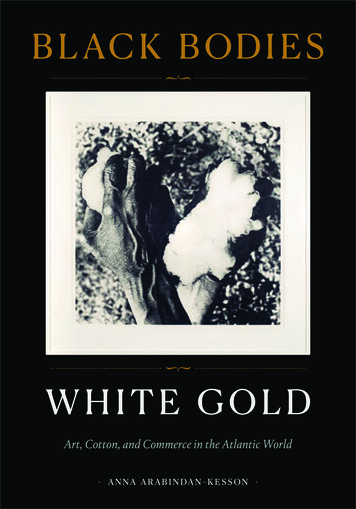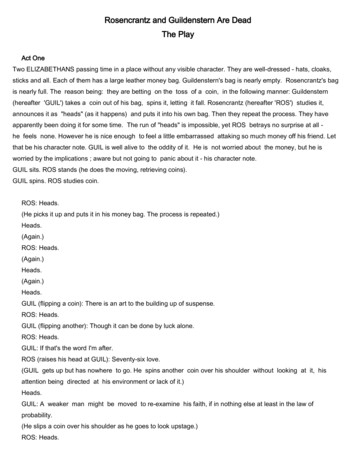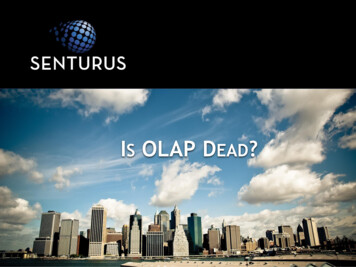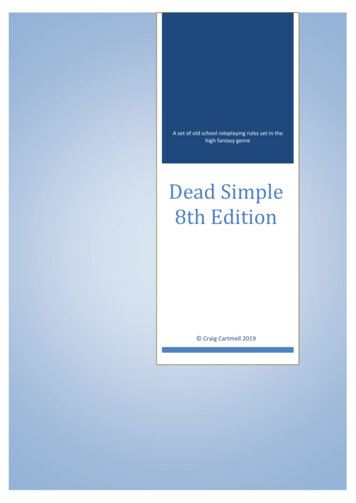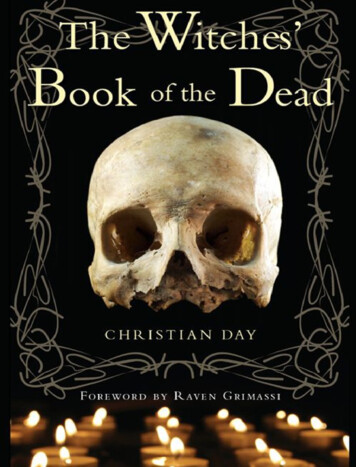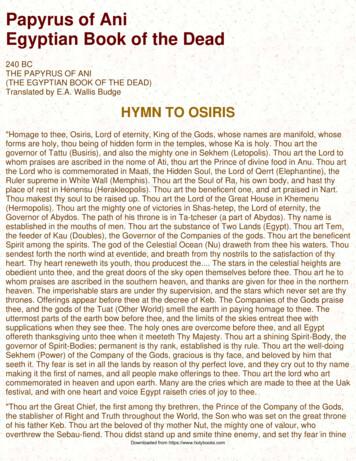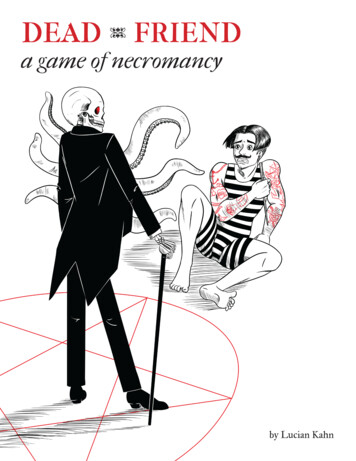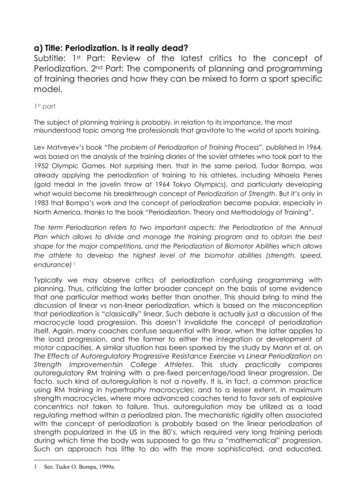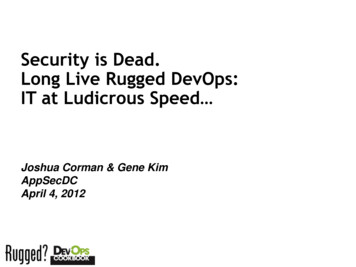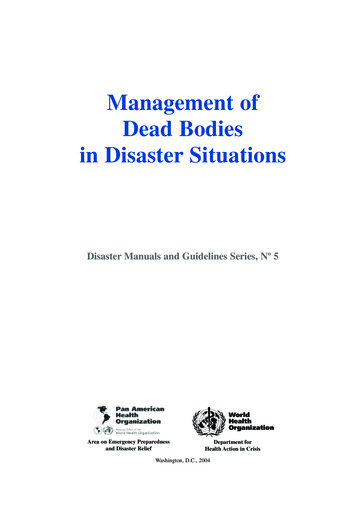
Transcription
Management ofDead Bodiesin Disaster SituationsDisaster Manuals and Guidelines Series, Nº 5WorldHealthOrganizationArea on Emergency Preparednessand Disaster ReliefDepartment forHealth Action in CrisisWashington, D.C., 2004
Also published in Spanish (2004 with the title:Manejo de cadáveres en situaciones de desastre (ISBN 92 75 32529 4)PAHO Cataloguing in PublicationPan American Health OrganizationManagement of Dead Bodies in Disaster SituationsWashington, D.C: PAHO, 2004.190p, -- (Disaster Manuals and Guidelines on Disasters Series, Nº 5)ISBN 92 75 12529 5I. Title II. Series1. DEAD BODY2. NATURAL DISASTER3. DISASTER EMERGENCIES4. DISASTER EPIDEMIOLOGYLC HC553 Pan American Health Organization, 2004A publication of the Area on Emergency Preparedness and Disaster Relief of the Pan AmericanHealth Organization (PAHO) in collaboration with the Department Health Action in Crises ofthe World Health Organization (WHO).The views expressed, the recommendations made, and the terms employed in this publicationdo not necessarily reflect the current criteria or policies of PAHO/WHO or of its MemberStates.The Pan American Health Organization welcomes requests for permission to reproduce ortranslate, in part or in full, this publication. Applications and inquiries should be addressed tothe Area on Emergency Preparedness and Disaster Relief, Pan American Health Organization,525 Twenty-third Street, N.W., Washington, D.C. 20037, USA; fax: (202) 775-4578; e-mail:disaster-publications@paho.org.This publication has been made possible through the financial support of the Division ofHumanitarian Assistance, Peace and Security of the Canadian International DevelopmentAgency (IHA/CIDA), the Office for Foreign Disaster Assistance of the United States Agencyfor International Development (OFDA/USAID), the United Kingdom’s Department forInternational Development (DFID), the Swedish International Development CooperationAgency (SIDA), and The European Commission’s Humanitarian Aid department (ECHO).Cover and interior photos: PAHO/WHO
ContentsForeword . . . . . . . . . . . . . . . . . . . . . . . . . . . . . . . . . . . . . . . . . . . . . . . . . . . . . . . . .ixPreface. . . . . . . . . . . . . . . . . . . . . . . . . . . . . . . . . . . . . . . . . . . . . . . . . . . . . . . . .xiAcknowledgements . . . . . . . . . . . . . . . . . . . . . . . . . . . . . . . . . . . . . . . . . . . . . . . .xiiiChapter 1. Preparedness for mass deathsIntroduction . . . . . . . . . . . . . . . . . . . . . . . . . . . . . . . . . . . . . . . . . . . . . . . . . . . . . . .1Coordinating institutions. . . . . . . . . . . . . . . . . . . . . . . . . . . . . . . . . . . . . . . . . . .2Duties . . . . . . . . . . . . . . . . . . . . . . . . . . . . . . . . . . . . . . . . . . . . . . . . . . . . . . . . .3Preparation of the plan . . . . . . . . . . . . . . . . . . . . . . . . . . . . . . . . . . . . . . . . . . . .4Technical programs . . . . . . . . . . . . . . . . . . . . . . . . . . . . . . . . . . . . . . . . . . . . . . . . .5Body identification . . . . . . . . . . . . . . . . . . . . . . . . . . . . . . . . . . . . . . . . . . . . . . .5Epidemiologic surveillance and disease control . . . . . . . . . . . . . . . . . . . . . . . .5Training . . . . . . . . . . . . . . . . . . . . . . . . . . . . . . . . . . . . . . . . . . . . . . . . . . . . . . . .6Simulations . . . . . . . . . . . . . . . . . . . . . . . . . . . . . . . . . . . . . . . . . . . . . . . . . . . . .7Relations with the community . . . . . . . . . . . . . . . . . . . . . . . . . . . . . . . . . . . . . . . .8Relations with the media . . . . . . . . . . . . . . . . . . . . . . . . . . . . . . . . . . . . . . . . . . . .8Questions commonly asked after a disaster . . . . . . . . . . . . . . . . . . . . . . . . . . . .9Guidelines for the official spokesperson . . . . . . . . . . . . . . . . . . . . . . . . . . . . . .9Proactive approach to media relations for the official spokesperson . . . . . . . .9Conclusions . . . . . . . . . . . . . . . . . . . . . . . . . . . . . . . . . . . . . . . . . . . . . . . . . . . . . .10Bibliography . . . . . . . . . . . . . . . . . . . . . . . . . . . . . . . . . . . . . . . . . . . . . . . . . . . . . .11Chapter 2. Medicolegal work in major disastersIntroduction . . . . . . . . . . . . . . . . . . . . . . . . . . . . . . . . . . . . . . . . . . . . . . . . . . . . . .13Organization of necessary personnel . . . . . . . . . . . . . . . . . . . . . . . . . . . . . . . . . .14Organization and preparation of the team . . . . . . . . . . . . . . . . . . . . . . . . . . . .14Formation of the group and the warning plan . . . . . . . . . . . . . . . . . . . . . . . . .15Risk and vulnerability studies . . . . . . . . . . . . . . . . . . . . . . . . . . . . . . . . . . . . .15Technical preparation of the team . . . . . . . . . . . . . . . . . . . . . . . . . . . . . . . . . .16Cooperation agreements . . . . . . . . . . . . . . . . . . . . . . . . . . . . . . . . . . . . . . . . . .16Exercises and simulations . . . . . . . . . . . . . . . . . . . . . . . . . . . . . . . . . . . . . . . .17Material needs . . . . . . . . . . . . . . . . . . . . . . . . . . . . . . . . . . . . . . . . . . . . . . . . .18Transport . . . . . . . . . . . . . . . . . . . . . . . . . . . . . . . . . . . . . . . . . . . . . . . . . . . . . .19iii
MANAGEMENTOFDEADBODIESINDISASTERS I T U AT I O N SCommunications . . . . . . . . . . . . . . . . . . . . . . . . . . . . . . . . . . . . . . . . . . . . . . . .20Protective clothing and equipment . . . . . . . . . . . . . . . . . . . . . . . . . . . . . . . . . .21Instruments and equipment . . . . . . . . . . . . . . . . . . . . . . . . . . . . . . . . . . . . . . .23Body preservation measures . . . . . . . . . . . . . . . . . . . . . . . . . . . . . . . . . . . . . . .24Temporary work cams or sites . . . . . . . . . . . . . . . . . . . . . . . . . . . . . . . . . . . . .25Water and food . . . . . . . . . . . . . . . . . . . . . . . . . . . . . . . . . . . . . . . . . . . . . . . . .26Medical care . . . . . . . . . . . . . . . . . . . . . . . . . . . . . . . . . . . . . . . . . . . . . . . . . . .27Participants . . . . . . . . . . . . . . . . . . . . . . . . . . . . . . . . . . . . . . . . . . . . . . . . . . . . . .27Disaster professionals . . . . . . . . . . . . . . . . . . . . . . . . . . . . . . . . . . . . . . . . . . . .27Other participants in disaster response . . . . . . . . . . . . . . . . . . . . . . . . . . . . . . .31Operations coordination . . . . . . . . . . . . . . . . . . . . . . . . . . . . . . . . . . . . . . . . . . . .32Search for information . . . . . . . . . . . . . . . . . . . . . . . . . . . . . . . . . . . . . . . . . . .33The place, the event, and the hazards . . . . . . . . . . . . . . . . . . . . . . . . . . . . . . .33Presumed victims . . . . . . . . . . . . . . . . . . . . . . . . . . . . . . . . . . . . . . . . . . . . . . .34Removal of dead bodies . . . . . . . . . . . . . . . . . . . . . . . . . . . . . . . . . . . . . . . . . . . .36Procedures at the disaster site . . . . . . . . . . . . . . . . . . . . . . . . . . . . . . . . . . . . .37Transfer of human remains . . . . . . . . . . . . . . . . . . . . . . . . . . . . . . . . . . . . . . .41Holding and examination site . . . . . . . . . . . . . . . . . . . . . . . . . . . . . . . . . . . . . .41Holding area . . . . . . . . . . . . . . . . . . . . . . . . . . . . . . . . . . . . . . . . . . . . . . . . . . .41Viewing area . . . . . . . . . . . . . . . . . . . . . . . . . . . . . . . . . . . . . . . . . . . . . . . . . . .43Examination area . . . . . . . . . . . . . . . . . . . . . . . . . . . . . . . . . . . . . . . . . . . . . . .43Methods for identifying human remains . . . . . . . . . . . . . . . . . . . . . . . . . . . . . . .44Identification using visual recognition . . . . . . . . . . . . . . . . . . . . . . . . . . . . . . .44Identification using anthropological studies . . . . . . . . . . . . . . . . . . . . . . . . . .45Other methods of identification . . . . . . . . . . . . . . . . . . . . . . . . . . . . . . . . . . . .47DNA identification . . . . . . . . . . . . . . . . . . . . . . . . . . . . . . . . . . . . . . . . . . . . . . . . .47Historic background . . . . . . . . . . . . . . . . . . . . . . . . . . . . . . . . . . . . . . . . . . . . .47DNA identification process . . . . . . . . . . . . . . . . . . . . . . . . . . . . . . . . . . . . . . .49Accepting cases, managing evidence, and maintainingchain of custody in DNA typing . . . . . . . . . . . . . . . . . . . . . . . . . . . . . . . . . . .51Final disposal of corpses . . . . . . . . . . . . . . . . . . . . . . . . . . . . . . . . . . . . . . . . . . . .58Low temperatures . . . . . . . . . . . . . . . . . . . . . . . . . . . . . . . . . . . . . . . . . . . . . . .59Chemical processes . . . . . . . . . . . . . . . . . . . . . . . . . . . . . . . . . . . . . . . . . . . . .59iv
CONTENTSEmbalming . . . . . . . . . . . . . . . . . . . . . . . . . . . . . . . . . . . . . . . . . . . . . . . . . . . .60Burial . . . . . . . . . . . . . . . . . . . . . . . . . . . . . . . . . . . . . . . . . . . . . . . . . . . . . . . .65Bibliography . . . . . . . . . . . . . . . . . . . . . . . . . . . . . . . . . . . . . . . . . . . . . . . . . . . . .66Special bibliography on DNA . . . . . . . . . . . . . . . . . . . . . . . . . . . . . . . . . . . . . . . .68Chapter 3. Health considerations in cases of mass fatalitiesIntroduction . . . . . . . . . . . . . . . . . . . . . . . . . . . . . . . . . . . . . . . . . . . . . . . . . . . . . .71Myths. . . . . . . . . . . . . . . . . . . . . . . . . . . . . . . . . . . . . . . . . . . . . . . . . . . . . . . . .72Epidemiological risk of dead bodies in areaswith endemic diseases . . . . . . . . . . . . . . . . . . . . . . . . . . . . . . . . . . . . . . . . . . . . . .73Scientific basis of the absence of epidemiologicalrisk in non-endemic areas . . . . . . . . . . . . . . . . . . . . . . . . . . . . . . . . . . . . . . . . . . .76Animal corpses . . . . . . . . . . . . . . . . . . . . . . . . . . . . . . . . . . . . . . . . . . . . . . . . . . . .78Conclusions . . . . . . . . . . . . . . . . . . . . . . . . . . . . . . . . . . . . . . . . . . . . . . . . . . . . . .81Bibliography . . . . . . . . . . . . . . . . . . . . . . . . . . . . . . . . . . . . . . . . . . . . . . . . . . . . . .83Chapter 4. Sociocultural aspectsIntroduction . . . . . . . . . . . . . . . . . . . . . . . . . . . . . . . . . . . . . . . . . . . . . . . . . . . . . .85The funeral rite . . . . . . . . . . . . . . . . . . . . . . . . . . . . . . . . . . . . . . . . . . . . . . . . . . .86Changes in funeral rites through history . . . . . . . . . . . . . . . . . . . . . . . . . . . . .88Influence of culture, religion, and history on funeral . . . . . . . . . . . . . . . . . . .89The symbolic value of the corpse and burial . . . . . . . . . . . . . . . . . . . . . . . . . . .95Mourning and rituals in disaster situations . . . . . . . . . . . . . . . . . . . . . . . . . . . .97Unresolved grief . . . . . . . . . . . . . . . . . . . . . . . . . . . . . . . . . . . . . . . . . . . . . . . . . .98Arguments for the rapid disposal of corpses . . . . . . . . . . . . . . . . . . . . . . . . . .100Disaster management experiences . . . . . . . . . . . . . . . . . . . . . . . . . . . . . . . . . . .101Conclusions . . . . . . . . . . . . . . . . . . . . . . . . . . . . . . . . . . . . . . . . . . . . . . . . . . . . .104Bibliography . . . . . . . . . . . . . . . . . . . . . . . . . . . . . . . . . . . . . . . . . . . . . . . . . . . . .106Chapter 5. Psychological aspectsIntroduction . . . . . . . . . . . . . . . . . . . . . . . . . . . . . . . . . . . . . . . . . . . . . . . . . . . . .109Specific vulnerabilities . . . . . . . . . . . . . . . . . . . . . . . . . . . . . . . . . . . . . . . . . . . .110Grief. . . . . . . . . . . . . . . . . . . . . . . . . . . . . . . . . . . . . . . . . . . . . . . . . . . . . . . .111v
MANAGEMENTOFDEADBODIESINDISASTERS I T U AT I O N SThe process of unresolved grief . . . . . . . . . . . . . . . . . . . . . . . . . . . . . . . . . . . . .113Psychiatirc disorders among survivors . . . . . . . . . . . . . . . . . . . . . . . . . . . . . . .116Notification of disappearance or death, andvisual recognition of corpses . . . . . . . . . . . . . . . . . . . . . . . . . . . . . . . . . . . . . . .119Psychosocial care for survivors . . . . . . . . . . . . . . . . . . . . . . . . . . . . . . . . . . . . .121Psychosocial care for first response teams . . . . . . . . . . . . . . . . . . . . . . . . . . . .123The importance of truthful, approriate, andtimely information . . . . . . . . . . . . . . . . . . . . . . . . . . . . . . . . . . . . . . . . . . . . . . . .125Role of the authorities . . . . . . . . . . . . . . . . . . . . . . . . . . . . . . . . . . . . . . . . . . . . .126Conclusions . . . . . . . . . . . . . . . . . . . . . . . . . . . . . . . . . . . . . . . . . . . . . . . . . . . . .126Bibliography . . . . . . . . . . . . . . . . . . . . . . . . . . . . . . . . . . . . . . . . . . . . . . . . . . . . .128Chapter 6. Legal aspectsIntroduction . . . . . . . . . . . . . . . . . . . . . . . . . . . . . . . . . . . . . . . . . . . . . . . . . . . . .129General regulations on managing corpses . . . . . . . . . . . . . . . . . . . . . . . . . . . .129Unidentified bodies . . . . . . . . . . . . . . . . . . . . . . . . . . . . . . . . . . . . . . . . . . . .130Missing persons . . . . . . . . . . . . . . . . . . . . . . . . . . . . . . . . . . . . . . . . . . . . . . .131Identification of numerous corpses . . . . . . . . . . . . . . . . . . . . . . . . . . . . . . . . . .134Consequences of failure to identify corpses . . . . . . . . . . . . . . . . . . . . . . . . . . .135Provisions of national law . . . . . . . . . . . . . . . . . . . . . . . . . . . . . . . . . . . . . . .135Provisions of international law . . . . . . . . . . . . . . . . . . . . . . . . . . . . . . . . . . . .138Conclusions . . . . . . . . . . . . . . . . . . . . . . . . . . . . . . . . . . . . . . . . . . . . . . . . . . . . .146Model law for management of dead bodies indisaster situations . . . . . . . . . . . . . . . . . . . . . . . . . . . . . . . . . . . . . . . . . . . . . . . .148Bibliography . . . . . . . . . . . . . . . . . . . . . . . . . . . . . . . . . . . . . . . . . . . . . . . . . . . . .151Chapter 7. Case studiesThe Peruvian experience in managing dead bodies indisaster situations: The Mesa Redonda fire, 2001 . . . . . . . . . . . . . . . . . . . . . .153Introduction . . . . . . . . . . . . . . . . . . . . . . . . . . . . . . . . . . . . . . . . . . . . . . . . . .153Actions of the Public Prosecutor’s Office . . . . . . . . . . . . . . . . . . . . . . . . . . .154Actions of the Legal Medicine Institute of Peru . . . . . . . . . . . . . . . . . . . . . .155Activities of the Public Ministry . . . . . . . . . . . . . . . . . . . . . . . . . . . . . . . . . .155vi
CONTENTSPublic Ministry staff involved . . . . . . . . . . . . . . . . . . . . . . . . . . . . . . . . . . . .158Achievements . . . . . . . . . . . . . . . . . . . . . . . . . . . . . . . . . . . . . . . . . . . . . . . . .159Problems . . . . . . . . . . . . . . . . . . . . . . . . . . . . . . . . . . . . . . . . . . . . . . . . . . . . .160Repercussions of the event . . . . . . . . . . . . . . . . . . . . . . . . . . . . . . . . . . . . . . .161Conclusions and recommendations . . . . . . . . . . . . . . . . . . . . . . . . . . . . . . . .162Management of dead bodies following the avalancheof the Casitas volcano in Nicaragua: Chronicle of adisaster within a disaster . . . . . . . . . . . . . . . . . . . . . . . . . . . . . . . . . . . . . . . . . .163Summary . . . . . . . . . . . . . . . . . . . . . . . . . . . . . . . . . . . . . . . . . . . . . . . . . . . . .163Introduction . . . . . . . . . . . . . . . . . . . . . . . . . . . . . . . . . . . . . . . . . . . . . . . . . .163Materials and methods . . . . . . . . . . . . . . . . . . . . . . . . . . . . . . . . . . . . . . . . . .164Results . . . . . . . . . . . . . . . . . . . . . . . . . . . . . . . . . . . . . . . . . . . . . . . . . . . . . .164The scene of the disaster . . . . . . . . . . . . . . . . . . . . . . . . . . . . . . . . . . . . . . . .165Institutional response . . . . . . . . . . . . . . . . . . . . . . . . . . . . . . . . . . . . . . . . . . .166Management of dead bodies . . . . . . . . . . . . . . . . . . . . . . . . . . . . . . . . . . . . . .166Discussion . . . . . . . . . . . . . . . . . . . . . . . . . . . . . . . . . . . . . . . . . . . . . . . . . . . .168Bibliography . . . . . . . . . . . . . . . . . . . . . . . . . . . . . . . . . . . . . . . . . . . . . . . . . .170Final recommendations . . . . . . . . . . . . . . . . . . . . . . . . . . . . . . . . . . . . . . . . .171Myths and realities of management of deadbodies in disasters . . . . . . . . . . . . . . . . . . . . . . . . . . . . . . . . . . . . . . . . . . . . . . .172Glossary . . . . . . . . . . . . . . . . . . . . . . . . . . . . . . . . . . . . . . . . . . . . . . . . . . . . . . . .173vii
FOREWORDOur Region has been the victim of different types of disasters that have had significant, long-term consequences for the development of communities, intensifying thepoverty and increasing obstacles to progress, particularly among populations withscarce economic resources.Death does not end human suffering, especially when death is sudden, as the resultof a disaster. The death of a loved one leaves an indelible mark on the survivors, andunfortunately, because of the lack of information, the families of the deceased sufferadditional harm because of the inadequate way that the bodies of the dead are handled.These secondary injuries are unacceptable, particularly if they are the consequence ofdirect authorization or action on the part of the authorities or those responsible forhumanitarian assistance.Regrettably, we continue to be witness to the use of common graves and mass cremations for the rapid disposal of dead bodies owing to the myths and beliefs thatcorpses pose a high risk for epidemics. The most serious aspect is that these measuresare carried out without respecting identification processes or preserving the individuality of the deceased. Not only do these actions go against the cultural and religiouspractices of a population, but they have social, psychological, emotional, economic,and legal repercussions regarding the legacy of the deceased, which exacerbate thedamage caused by the disaster.The State has a critical role in standardizing and guiding the tasks of handling deadbodies (recovery, identification, transfer, and final disposal), ensuring that legal normsare followed, and guaranteeing that the dignity of the deceased and their families isrespected in accordance with their cultural values and religious beliefs.The Pan American Health Organization (PAHO) is pleased to present this manual,which will be very useful for authorities and those responsible for disaster preventionand response. It is our goal to ensure that the management of massive fatalities formspart of disaster preparedness and response plans, and that it is a fundamental aspect ofhumanitarian assistance to survivors and rehabilitation and reconstruction programs. Inthis way we can preserve the memory and dignity of those who have passed before us.Mirta Roses PeriagoDirectorPan American Health Organizationix
INTRODUCTION“We should treat the dead with respect. In death,money doesn't matter, material possessions don't matter;dignity is what we should care about."—statement byGung Tresna, Lifeguard at Kuta Beach following the terrorist attack in Bali, Indonesia.Major disasters occurring in this Region, regardless of their origin, have had onething in common: an enormous number of fatalities. Hurricane Mitch in CentralAmerica, floods in Venezuela, the earthquake in El Salvador, hurricanes in theCaribbean, and disasters of human origin—such as the Mesa Redonda fire in Lima,wars, or aviation accidents, to name a few—have resulted in many deaths. Each disaster has yielded important evidence about handling bodies, particularly when thenumber of dead overwhelms the capacity of a country to effectively respond to anemergency.Immediately following the onset of a disaster, it is essential for national, regional, or local authorities to concentrate their actions and resources on three basic activities: first, the rescue and treatment of survivors; second, the repair and maintenanceof basic services; and, finally, the recovery and management of bodies.Controversy has always surrounded the handling of mass fatalities. Myths abouttreatment of the dead are strongly rooted in culture. Contemplating massive measlesvaccination campaigns after an earthquake because of the fear that corpses couldtransmit this disease, or burying or incinerating corpses without completing requiredidentification processes because of the supposed contamination risk they pose, arejust two examples of the myths that form part of the popular culture. Despite effortsby experts to dispel these and other beliefs, certain fallacies have led and continue tolead to unacceptable practices in managing dead bodies. For example, after the earthquake in India in 2001, in which the number of fatalities approached 100,000, thebodies recovered were cremated. The wood supply was quickly exhausted, leavingthe survivors without enough fuel for cooking or heating.1Considering these factors, PAHO’s Area on Emergency Preparedness and DisasterRelief has developed this manual as a tool to be used by national and local authorities and professionals from public institutions that are affected by this issue.This manual provides the technical information that will support the correctapproach to handling dead bodies, taking into account the following principles:u When death is the result of a disaster, the body does not pose a risk for infection;u Victims should never be buried in common graves;u Mass cremation of bodies should never take place when this goes against the cultural and religious norms of the population;1de Ville de Goyet. “Stop propagating disaster myths”. Lancet 2000; 356:762-4.xi
MANAGEMENTOFDEADBODIESINDISASTERS I T U AT I O N Su Every effort must be taken to identify the bodies. As a last resort, unidentifiedbodies should be placed in individual niches or trenches, which is a basichuman right of the surviving family members.xii
ACKNOWLEDGEMENTSThe preparation and technical review of this publication are the result of the valuable support of many professional from the countries of the Region of the Americas,under the general coordination of Gustavo Iturralde, with the counsel of Jean LucPoncelet and Ciro Ugarte of the Area on Emergency Preparedness and Disaster Reliefof the Pan American Health Organization.In particular, we would like to acknowledge the excellent contributions made bythe authors of the chapters of this manual: Jorge González and Alicia Basanta,Beatriz Lizárraga, Karl Western, Mary Luz Morales and Marlén Quintero, JorgeRodríguez and Susana Castiglione, Judith Romero, and Zacarías Duarte. The publication would not have been possible without their collaboration.We would also like to the thank the following individuals and institutions whoprovided valuable comments during the review process of the manual: JudithMaguiña of the Instituto de Medicina Legal (Legal Medicine Institute) in Peru; HugoArgüello and Zacarías Duarte of the Instituto de Medicina Legal in Nicaragua;Amílcar Rodas of the Department of Forensic Medicine in Honduras; EduardoFuhrer of the Agriculture and Livestock Service of the Ministry of Agriculture inChile; and María Estela García of the Instituto de Medicina Legal of El Salvador.We would also like to acknowledge the support of various national and international organizations: the Attorney General’s Office and Public Ministry of Peru; theLegal Medicine Institute, the Ministry of Social Welfare, and the NationalDirectorate for Disaster Prevention and Response (DNPAD) of Colombia; the CivilDefense of Nicaragua; and the World Bank.Contributions from other regional offices of the World Health Organization, aswell as from other international organizations increased the scope of the publication.We would like to acknowledge, in particular, the assistance of Michel Thieren, EricNoji, and Luis Jorge Pérez.Mary Elizabeth Stonaker edited the final English version of the manual under thegeneral supervision of Ricardo Pérez of the Area on Emergency Preparedness andDisaster Relief of PAHO/WHO.Many other individuals enhanced this text with their comments and suggestions.We are grateful to all of you.xiii
xiv
CHAPTER 1: PREPAREDNESS FORMASS FATALITIESThe management of dead bodies involves a series of activities that begins with thesearch for corpses, in situ identification of the body, transfer to the facility that serves asa morgue, delivery of the body to family members, and assistance from the State for finaldisposal of the body in accordance with the wishes of the family and the religious and cultural norms of the community. It requires the involvement of a diverse team of people,including rescue personnel, forensic medicine experts, prosecutors, police, administrativepersonnel, psychologists, support teams for the personnel who are directly handling thebodies, representatives from nongovernmental and international organizations, as well ascommunity volunteers. The State must manage this activity with utmost conscientiousnessand professionalism, covering all the aspects mentioned above. The health sector shouldtake the leading role in addressing concerns about the supposed epidemiological risksposed by dead bodies, and by providing medical assistance to family members of the victims.INTRODUCTIONIn disaster situations, the State and its authorities are responsible not only forbeing prepared to effectively provide immediate assistance to disaster victims and tomaintain basic services following an event. It is also the State’s responsibility toattend to the handling and final disposal of dead bodies resulting from the disaster,regardless of their number.In many cases, management of human remains has not been given the attention itdeserves, and has even been disregarded. It is important to clarify that the priority isto assist disaster survivors and to maintain basic services, but we cannot overlook therecovery of dead bodies.This chapter aims to provide a general overview of the authorities’ obligations indealing with this issue. The State must assume the leading role in the entire process,that is, to organize health services, legal services, forensic services, and the otheractors involved in managing dead bodies. Without neglecting resources destined forthe living, there must be an integrated plan to serve the needs of the dead. One mustalways keep in mind that the way corpses are managed has a significant impact onthe wellbeing of surviving family members.1
MANAGEMENTOFDEADBODIESINDISASTERS I T U AT I O N SCOORDINATING INSTITUTIONSThe management of dead bodies involves a series of activities that begin with thesearch for corpses, in situ identification of the body, transfer to the facility that servesas a morgue, delivery of the body to family members, and assistance from the Statefor final disposal of the body in accordance to the wishes of the family and following the religious and cultural norms of the community. It requires the involvement ofa diverse team of people, including rescue personnel, forensic medicine experts,prosecutors, police, administrative personnel, psychologists, support teams for thepersonnel who are directly handling the bodies, representatives from nongovernmental and international organizations, as well as community volunteers.There should be adequate coordination among all of the actors to avoid misuse ofresources or duplicated efforts. To that end, one of the tasks of the EmergencyOperations Committee of a country should be the management of dead bodies in disaster situations. If this function is not assigned by law to an institution that is a member of the Emergency Committee, the responsible institution should be specified (forexample, the public attorney’s office, the public ministry, judicial branch, health ministry, etc.)The responsible institution should coordinate other institutions in their respectivetasks related to handling the dead. The services of all relevant institutions, includingpsychological counseling for relatives, should be immediately available (on a daily,uninterrupted basis) after a disaster strikes. Typically, this coordinating role falls tothe attorney general’s office, judicial entity, or another public agency responsible fora State’s internal security. Failure to provide this coordination will negatively affectthe entire process of managing dead bodies during a disaster.To cite an example, an aviation accident occurred in one of the countries inthis Region on a holiday. The public offices were closed, and there was no onein the registry office to help with the legalities of identifying the bodies andproviding death certificates. It was necessary to wait until the next businessday to complete necessary legal transactions.2
C H A P T E R 1 : P R E PA R E D N E S S F O R M A S S D E AT H STable 1.1. Administrative structures for management of dead bodiesManagement of dead bodiesCoordinated by:For exampleResponsible institutionSupported by:AttorneyGeneral’soffice,Ministry ofthe Interior,etc.Inter-institutional teamSearch and recovery- Civil defenseagency- Fire department- Red Cross- Publicprosecutor’sofficeIdentification-Interior ministryHealth ministryPublic ministryLegal medicineinstitute- Attorneygeneral’s officeFinal ral governmentAssistanc
Caribbean, and disasters of human origin—such as the Mesa Redonda fire in Lima, wars, or aviation accidents, to name a few—have resulted in many deaths. Each dis-aster has yielded important evidence about handling bodies, particularly when the number of dead overwhelms the capa
